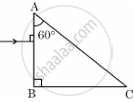Advertisements
Advertisements
Question
| A prism is an optical medium bounded by three refracting plane surfaces. A ray of light suffers successive refractions on passing through its two surfaces and deviates by a certain angle from its original path. The refractive index of the material of the prism is given by `mu = sin((A + deltam)/2)//sin A/2`. If the angle of incidence on the second surface is greater than an angle called critical angle, the ray will not be refracted from the second surface and is totally internally reflected. |
A ray of light is incident normally on a prism ABC of refractive index `sqrt2`, as shown in figure. After it strikes face AC, it will ______.

Options
go straight undeviated
just graze along the face AC
refract and go out of the prism
undergo total internal reflection
MCQ
Fill in the Blanks
Solution
A ray of light is incident normally on a prism ABC of refractive index `sqrt2`, as shown in figure. After it strikes face AC, it will undergo total internal reflection.
Explanation:
`mu = sqrt2`
⇒ `sini_c = 1/mu = 1/sqrt2`
ic = 45°
Now,

As the incident angle is greater than the critical angle, the ray will undergo total internal reflection.
shaalaa.com
Is there an error in this question or solution?
